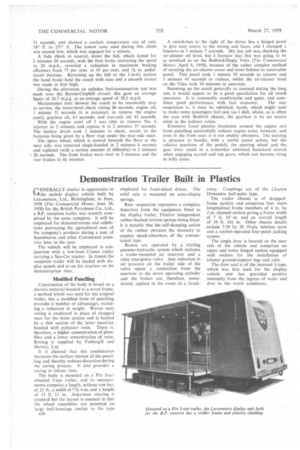Demonstration Trailer Built in Plastics
Page 54

If you've noticed an error in this article please click here to report it so we can fix it.
GENERALLY similar in appearance to the mobile display vehicle built by Locumotors, Ltd., Birmingham, in June, 1958 (The Commercial Motor, June 20, 1958) for the British Petroleum Co., Ltd., a B.P. reception trailer was recently completed by the same company. It will be employed for demonstrations and exhibitions portraying the agricultural uses of the company's products during a tour of Scandinavia and other Continental countries later in the year.
The vehicle will be employed in conjunction with a low-load Cranes trailer carrying a Sno-Cat tractor. In transit the reception trailer will be loaded with display panels and so on for erection on the demonstration sites.
Modified Panelling
Construction of the body is based on a plastics material bonded to a wood frame, a method which was used for the original trailer, but a modified form of panelling provides a number of advantages, including a reduction in weight. Woven matt roving is employed in place of chopped matt for the main section and is backed by a thin section of the latter material, bonded with polyester resin. There is. therefore, a higher concentration of glassfibre and a lower concentration of resin. Roving is supplied by Fothergill and Harvey, Ltd.
It is claimed that this combination increases the surface tension of the panelling and thereby reduces distortion during the curing process. It also provides a saving in labour time.
The body is mounted on a Pitt fourwheeled 5-ton trailer, and its measurements comprise a length, without tow bar, of 21 ft., a width of 7 ft. 6 in. and a height of 13 ft. 11 in. Ackerman steering is retained but the layout is unusual in that the wheel assemblies are mounted on large bell-housings similar to the type n20 employed for front-wheel drives. The solid axle is mounted on semi-elliptic springs.
Rear suspension represents a complete departure from the equipment fitted to the display trailer, Flexitor independent rubber-bushed torsion springs being fitted. It is notable that the self-damping action of the rubber obviates the necessity to employ shock-absorbers of the conventional type.
Brakes are operated by a Girling pneumo-hydraulic system which includes a trailer-mounted air reservoir and a relay emergency valve, Any reduction in air pressure on the trailer side of the valve opens a connection from the reservoir to the servo operating cylinder and the brakes are, therefore, immediately applied in the event of a break
away. Couplings are of the Clayton Dewandre half-palm type.
The trailer chassis is of droppedframe pattern and comprises four main longitudinal frame members of 4 in. by 2 in. channel section giving a frame width of 7 ft. 10 in. and an overall length of 19 ft. 10+ in. Other chassis details include 7.50 by 20 10-ply tubeless tyres and a ratchet-operated four-point jacking system.
The single door is located on the near side of the vehicle and comprises an upper and lower hinged section equipped with sockets for the installation of tubular ground-support legs and rails.
The door seal is of the inverted J-type, which was first used for the display vehicle and has provided positive immunity from the ingress of water and dust in the worst conditions.




































































































